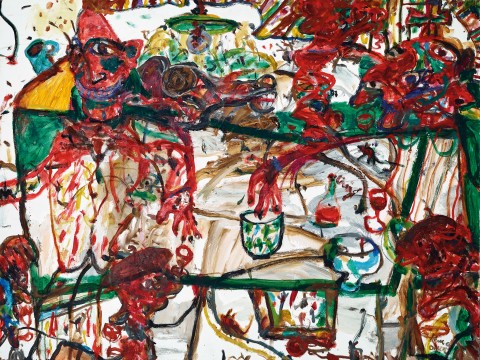SPANISH LUNCH, 1992
JOHN OLSEN
oil on composition board
92.0 cm x 122.0 cm
signed lower right: John Olsen
signed, dated and inscribed with title verso: SPANISH / LUNCH / John Olsen 92
Metro Gallery, Melbourne
Private collection, Melbourne
McGregor, K., John Olsen: Drawing – The Human Touch, Macmillan Art Publishing, Melbourne, 2014, p.67 (illus.)
In many ways, Olsen’s life and his art are inseparable. His oeuvre represents the cumulative response of an artist intoxicated with the landscape, its people and their attitudes towards food, life and art. The artist’s dedication to the good life is legendary, and this along with his love of poetry has inspired much of the artist’s work. The alchemy of the kitchen and the joyous conviviality of a shared meal in particular has been the subject of many of his most important paintings, often combined with memories of travels on the Iberian peninsula, including Portuguese Kitchen No. 1 and Portuguese Kitchen No. 2, both 1966, Love in the Kitchen, 1969, Duck à l’Orange, 1981, Spanish Kitchen, 1992 and Kitchen Story, 1993 (all various private collections). These later works, including Spanish Lunch, 1992, here, are vigorous and vibrant distillations of his recollections – revived and amplified by a return to Spain in 1985.
In her monograph on the artist in 1991, Deborah Hart revealed that it was necessity that introduced Olsen to the world of fine food: ‘In Ibiza and Deya, Olsen worked for brief periods as an apprentice chef. Before he left Australia he was hard pressed to boil an egg; by the time he returned he had developed a great admiration for Mediterranean attitudes to food and wine – the joy of preparing and sharing meals with feeling – which, even when enjoying the simplest ingredients, had the potential to add to the richness and celebration of life. This sensibility would remain with him always, and the subject of food, and paella in particular, would recur in his later paintings and drawings’.1
Olsen infuses his paintings with a life beyond the literal. They do not simply present an event as a static image, but as a rollicking yarn which unravels across the painting’s surface with often contradictory viewpoints. Olsen’s Spanish Lunch, 1992 is a cacophony of activity, in which the artist’s characteristic repertoire of marks are present in this celebratory painting. With diners’ arms stretching across the table to reach bowls and filled wine glasses, Olsen flexes his ability as a draughtsman and pushes the expressive limits of his medium.
As with most Olsen paintings, the line is central to the artist’s language as it forms the arteries that pulse colour around the canvas and bring life to the painting. In Spanish Lunch, against a stark white ground, Olsen’s gestures are emphatic in both line and colour. His brushstrokes collide and speed over one another with raw, untamed energy. They coalesce primarily in the four corners of the painting to form the grinning, ruddy faces of the diners, who share in the joys and mysteries of life around this disjointed table.
The parallels between cooking and painting are many - the studio and the kitchen, the table and the canvas, the ingredients and the paint. Even the line between kitchen utensils and the artist’s tools has blurred in recent decades. Olsen’s adaption of a cooking methodology to studio life has blended the two inseparably in his work. Perhaps it is this merged celebration of life which has kept his paintings feeling so vibrant and vital over decades of artistic practice.
1. Hart. D., John Olsen, Craftsman House, Sydney, 1991, p. 42
HENRY MULHOLLAND
